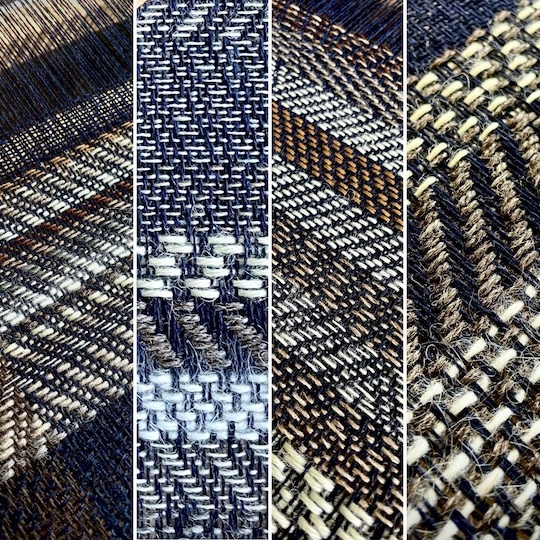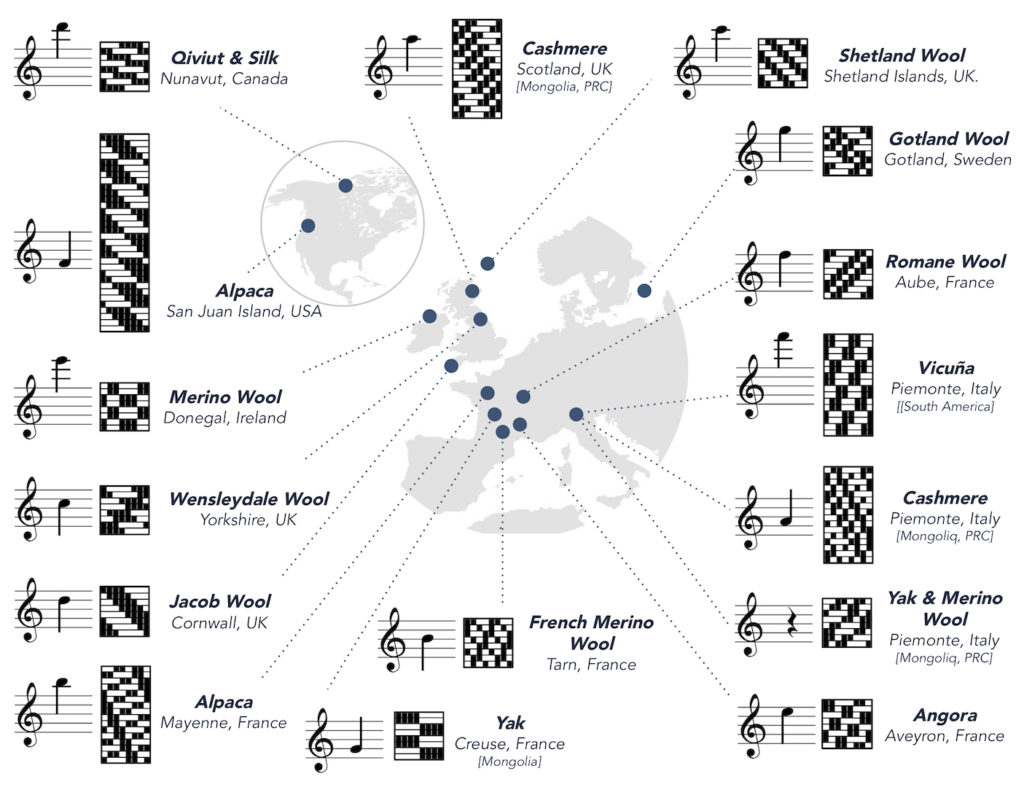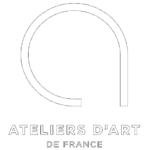
This creation, presented for the first time at the Révélations 2022 Fair at the Grand Palais Éphémère in Paris, is a woven transcription of the first movement of the Queen of the Night’s aria (second aria – “Der Hölle Rache…”) from W. A. Mozart’s Magic Flute.
This generously sized piece was conceived to highlight the vast visual and sensory palette offered by animal fibers, as well as to enhance the extraordinary richness of the patterns made possible by the weaving technique.
In this composition, 16 types of noble yarns and as many patterns cohabit to create a large and powerful piece, echoing the stormy song of Mozart’s Queen of the Night.
Discover here the keys to read this creation, as well as the stages of its conception.
THE PATTERN
Weaving The Morse Code
In the width of the scarf, the pattern develops in midnight blue or dark brown areas, each with diagonals that are sometimes short, sometimes long. This particular rhythm is that of the Morse code, a succession of short (•) and long (—) signs which the weaving adopts to transcribe the word “NACHT” (“Night” in German):
N A C H T
— • / • — / — • — • / • • • • / —
The columns drawn by short diagonals have the value of • and the wider columns those of —; each letter is represented by a shade of midnight blue or brown.

Encoding Music
The melody of the Queen of the Night aria (“Der Hölle Rache…”) unfolds along the length of the fabric, each note represented both by a different material and by a different pattern, the weaving following the rhythm of the composition: the fabric has become a music score.

In the woven transcription of this melody, each note is translated by a different yarn, as well as by a different pattern.
Atelier Le Traon carries out an important work of research and exploration of animal fibers, rich of an infinity of sensations and stories. Depending on the breed of the animal, on the terroir, on the spinning technique, each fiber will have its own personality, that Atelier Le Traons’s work seeks to emphasize.
Discover below the correspondence between notes, yarns and patterns.

At the start of the fabric, a kind of cartouche is woven playing the role of a G Key: between two midnight blue stripes, the color used in the “score” to represent the rests, each note is represented by a couple of threads of its yarn, and the yarns are organized in the order of the scale. To find your way around, the note G is represented with a band wider than the others (here, at the bottom of the picture, a thread of yak down spun in France in the Creuse region).

Accidentals (sharp, flat) are represented by the use of alternating threads of the two adjacent full notes: in this creation, the B flat is thus represented by the alternation of a thread of alpaca (the B) and a thread of worsted cashmere (the A).
On the edges of the scarf, the creation bears Atelier Le Traon’s textile signature in brown and blue cotton.
THE MAKING OF THE FABRIC
Warping
Preparation of the warp threads, which will then be set on the loom. These will be the vertical threads, between which the horizontal weft threads will pass.
The threads are organized in a precise order to be able to compose the message in width: NACHT
Passage en lisses et en peigne
Once the warp threads are rolled onto the loom, they are passed one by one through the links (the heddles) that connect them to the loom frames. During the weaving process, these frames will be successively raised and lowered in order to introduce the weft threads between the warp threads.
The 540 or so threads of the project are passed one by one through the heddles, in a precise order that will determine the pattern, like in the comparable project featured in the video below:
The 540 threads are then sleyed between the slots of the reed which will pack the weft threads introduced thanks to the shuttle. Once fully passed through the reed, the threads will be attached, the tension adjusted, and the weaving can begin.
Weaving
Weaving is a real dance, which engages the body, the heart and the mind: in a precise sequence ordered by the pattern, the feet push on treadles that activate the frames supporting the warp threads, between which the hand introduces the shuttle carrying the weft thread.
Off The Loom
At the end of the weaving process, the piece is unrolled and removed from the loom.
The fabric will then be fulled (washed and kneaded, massaged) to make the fibers “blossom“ and bind together, giving the fabric its final soft and light « hand ».
Often neglected, but nevertheless essential to give the fabric its own final character, the fulling stage is a subtle know-how that is very characteristic of the work of Atelier Le Traon.
And Finally…
The piece #77 “Königin der Nacht” reads like a real music score, which we suggest to discover while listening to Diana Damrau’s beautiful and inspired interpretation.



